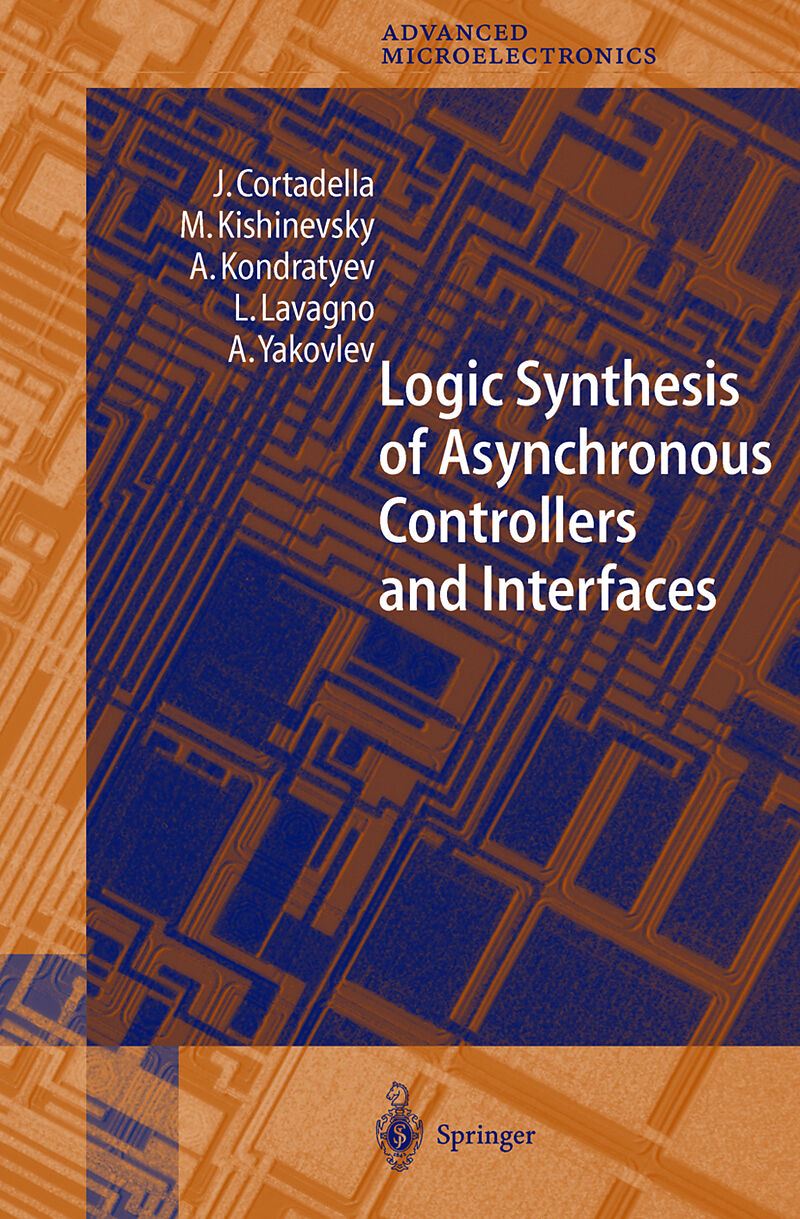Logic Synthesis for Asynchronous Controllers and Interfaces
Einband:
Fester Einband
EAN:
9783540431527
Untertitel:
Springer Series in Advanced Microelectronics 8
Genre:
Wärme- und Energietechnik
Autor:
J. Cortadella, M. Kishinevsky, A. Kondratyev, Luciano Lavagno, Alex Yakovlev
Herausgeber:
Springer, Berlin
Auflage:
2002
Anzahl Seiten:
273
Erscheinungsdatum:
2002
ISBN:
978-3-540-43152-7
This book systematically teaches the reader about computer-aided design of asynchronous circuits. It will appeal to researchers, electrical engineers and advanced students.
This is the first book addressing the computer-aided design of asynchronous circuits Includes supplementary material: sn.pub/extras
Klappentext
This book is devoted to logic synthesis and design techniques for asynchronous circuits. It uses the mathematical theory of Petri Nets and asynchronous automata to develop practical algorithms implemented in a public domain CAD tool. Asynchronous circuits have so far been designed mostly by hand, and are thus much less common than their synchronous counterparts, which have enjoyed a high level of design automation since the mid-1970s. Asynchronous circuits, on the other hand, can be very useful to tackle clock distribution, modularity, power dissipation and electro-magnetic interference in digital integrated circuits. This book provides the foundation needed for CAD-assisted design of such circuits, and can also be used as the basis for a graduate course on logic design.
Zusammenfassung
This book is the result of a long friendship, of a broad international co operation, and of a bold dream. It is the summary of work carried out by the authors, and several other wonderful people, during more than 15 years, across 3 continents, in the course of countless meetings, workshops and discus sions. It shows that neither language nor distance can be an obstacle to close scientific cooperation, when there is unity of goals and true collaboration. When we started, we had very different approaches to handling the mys terious, almost magical world of asynchronous circuits. Some were more theo retical, some were closer to physical reality, some were driven mostly by design needs. In the end, we all shared the same belief that true Electronic Design Automation research must be solidly grounded in formal models, practically minded to avoid excessive complexity, and tested "in the field" in the form of experimental tools. The results are this book, and the CAD tool petrify. The latter can be downloaded and tried by anybody bold (or desperate) enough to tread into the clockless (but not lawless) domain of small-scale asynchronicity. The URL is http://www.lsi. upc. esr j ordic/petrify. We believe that asynchronous circuits are a wonderful object, that aban dons some of the almost militaristic law and order that governs synchronous circuits, to improve in terms of simplicity, energy efficiency and performance.
Inhalt
1. Introduction.- 1.1 A Little History.- 1.2 Advantages of Asynchronous Logic.- 1.3 Asynchronous Control Circuits.- 2. Design Flow.- 2.1 Specification of Asynchronous Controllers.- 2.2 Transition Systems and State Graphs.- 2.3 Deriving Logic Equations.- 2.4 State Encoding.- 2.5 Logic Decomposition and Technology Mapping.- 2.6 Synthesis with Relative Timing.- 2.7 Summary.- 3. Background.- 3.1 Petri Nets.- 3.2 Structural Theory of Petri Nets.- 3.3 Calculating the Reachability Graph of a Petri Net.- 3.4 Transition Systems.- 3.5 Deriving Petri Nets from Transition Systems.- 3.6 Algorithm for Petri Net Synthesis.- 3.7 Event Insertion in Transition Systems.- 4. Logic Synthesis.- 4.1 Signal Transition Graphs and State Graphs.- 4.2 Implement ability as a Logic Circuit.- 4.3 Boolean Functions.- 4.4 Gate Netlists.- 4.5 Deriving a Gate Net list.- 4.6 What is Speed-Independence?.- 4.7 Summary.- 5. State Encoding.- 5.1 Methods for Complete State Coding.- 5.2 Constrained Signal Transition Event Insertion.- 5.3 Selecting SIP-Sets.- 5.4 Transformation of State Graphs.- 5.5 Completeness of the Method.- 5.6 An Heuristic Strategy to Solve CSC.- 5.7 Cost Function.- 5.8 Related Work.- 5.9 Summary.- 6. Logic Decomposition.- 6.1 Overview.- 6.2 Architecture-Based Decomposition.- 6.3 Logic Decomposition Using Algebraic Factorization.- 6.4 Logic Decomposition Using Boolean Relations.- 6.5 Experimental Results.- 6.6 Summary.- 7. Synthesis with Relative Timing.- 7.1 Motivation.- 7.2 Lazy Transition Systems and Lazy State Graphs.- 7.3 Overview and Example.- 7.4 Timing Assumptions.- 7.5 Synthesis with Relative Timing.- 7.6 Automatic Generation of Timing Assumptions.- 7.7 Back-Annotation of Timing Constraints.- 7.8 Experimental Results.- 7.9 Summary.- 8. Design Examples.- 8.1 Handshake Communication.- 8.2 VME Bus Controller.- 8.3 Controller for Self-timed A/D Converter.- 8.4 Lazy Token Ring Adapter.- 8.5 Other Examples.- 9. Other Work.- 9.1 Hardware Description Languages.- 9.2 Structural and Unfolding-based Synthesis.- 9.3 Direct Mapping of STGs into Asynchronous Circuits.- 9.4 Datapath Design and Interfaces.- 9.5 Test Pattern Generation and Design for Testability.- 9.6 Verification.- 9.7 Asynchronous Silicon.- 10. Conclusions.- References.

Leider konnten wir für diesen Artikel keine Preise ermitteln ...
billigbuch.ch sucht jetzt für Sie die besten Angebote ...
Die aktuellen Verkaufspreise von 6 Onlineshops werden in Realtime abgefragt.
Sie können das gewünschte Produkt anschliessend direkt beim Anbieter Ihrer Wahl bestellen.
Loading...
Die aktuellen Verkaufspreise von 6 Onlineshops werden in Realtime abgefragt.
Sie können das gewünschte Produkt anschliessend direkt beim Anbieter Ihrer Wahl bestellen.
| # | Onlineshop | Preis CHF | Versand CHF | Total CHF | ||
|---|---|---|---|---|---|---|
| 1 | Seller | 0.00 | 0.00 | 0.00 |
